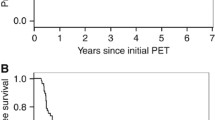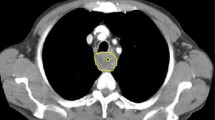Abstract
Objectives
To assess the prognostic value of volumetric parameters measured with CT and PET/CT in patients with neoadjuvant chemotherapy (NACT) and resection for oesophageal cancer (EC).
Methods
Patients with locally advanced EC, who were treated with NACT and resection, were retrospectively analysed. Data from CT volumetry and 18 F-FDG PET/CT (maximum standardized uptake [SUVmax], metabolic tumour volume [MTV], and total lesion glycolysis [TLG]) were recorded before and after NACT. The impact of volumetric parameter changes induced by NACT (MTVRATIO, TLGRATIO, etc.) on overall survival (OS) was assessed using a Cox proportional hazards model.
Results
Eighty-four patients were assessed using CT volumetry; of those, 50 also had PET/CT before and after NACT. Low post-treatment CT volume and thickness, MTV, TLG, and SUVmax were all associated with longer OS (p < 0.05), as were CTthicknessRATIO, MTVRATIO, TLGRATIO, and SUVmaxRATIO (p < 0.05). In the multivariate analysis, only MTVRATIO (Hazard ratio, HR 2.52 [95 % Confidence interval, CI 1.33–4.78], p = 0.005), TLGRATIO (HR 3.89 [95%CI 1.46–10.34], p = 0.006), and surgical margin status (p < 0.05), were independent predictors of OS.
Conclusions
MTVRATIO and TLGRATIO are independent prognostic factors for survival in patients after NACT and resection for EC.
Key points
• Change in PET parameters shows close correlation to survival in oesophageal cancer.
• Association with OS is independent of changes in SUVmax and CT volume.
• Metabolic parameters after NACT correlate with pathologic response and nodal status.
• Metabolic parameters may be better suited than SUVmax for response assessment.





Similar content being viewed by others
Abbreviations
- AEG:
-
Adenocarcinoma of the gastro-oesophageal junction
- CF:
-
Cisplatin and 5-fluorouracil
- CI:
-
Confidence interval
- DCF:
-
Docetaxel, cisplatin and 5-fluorouracil
- EC:
-
Oesophageal cancer
- EOX:
-
Epirubicin, oxaliplatin and Capecitabine
- ESCC:
-
Squamous cell oesophageal cancer
- FDG:
-
Fluoro-deoxyglucose
- HR:
-
Hazard ratio
- MTV:
-
Metabolic tumour volume
- NACT:
-
Neoadjuvant chemotherapy
- OS:
-
Overall survival
- RCHT:
-
Radiochemotherapy
- ROI:
-
Region of interest
- SUVmax:
-
Maximal standardized uptake value
- TLG:
-
Total lesion glycolysis
- VOI:
-
Volume of interest
References
Siewert JR, Stein HJ (1998) Classification of adenocarcinoma of the oesophagogastric junction. Br J Surg 85:1457–1459
Castro C, Bosetti C, Malvezzi M et al (2014) Patterns and trends in esophageal cancer mortality and incidence in Europe (1980-2011) and predictions to 2015. Ann Oncol 25:283–290
Gonzalez L, Magno P, Ortiz AP et al (2013) Esophageal cancer incidence rates by histological type and overall: Puerto Rico versus the United States Surveillance, Epidemiology, and End Results population, 1992-2005. Cancer Epidemiol 37:5–10
Dubecz A, Gall I, Solymosi N et al (2012) Temporal trends in long-term survival and cure rates in esophageal cancer: a SEER database analysis. J Thorac Oncol 7:443–447
Mariette C, Dahan L, Mornex F et al (2014) Surgery Alone Versus Chemoradiotherapy Followed by Surgery for Stage I and II Esophageal Cancer: Final Analysis of Randomized Controlled Phase III Trial FFCD 9901. J Clin Oncol. doi:10.1200/JCO.2013.53.6532
Minsky BD, Neuberg D, Kelsen DP et al (1999) Final report of Intergroup Trial 0122 (ECOG PE-289, RTOG 90-12): Phase II trial of neoadjuvant chemotherapy plus concurrent chemotherapy and high-dose radiation for squamous cell carcinoma of the esophagus. Int J Radiat Oncol Biol Phys 43:517–523
Cunningham D, Allum WH, Stenning SP et al (2006) Perioperative chemotherapy versus surgery alone for resectable gastroesophageal cancer. N Engl J Med 355:11–20
Gebski V, Burmeister B, Smithers BM et al (2007) Survival benefits from neoadjuvant chemoradiotherapy or chemotherapy in oesophageal carcinoma: a meta-analysis. Lancet Oncol 8:226–234
Yip C, Goh V, Davies A et al (2014) Assessment of sarcopenia and changes in body composition after neoadjuvant chemotherapy and associations with clinical outcomes in oesophageal cancer. Eur Radiol 24:998–1005
van Hagen P, Hulshof MC, van Lanschot JJ et al (2012) Preoperative chemoradiotherapy for esophageal or junctional cancer. N Engl J Med 366:2074–2084
Stahl M, Mariette C, Haustermans K, Cervantes A, Arnold D, Group EGW (2013) Oesophageal cancer: ESMO Clinical Practice Guidelines for diagnosis, treatment and follow-up. Ann Oncol 24(uppl 6):vi51–vi56
Lordick F, Ott K, Krause BJ et al (2007) PET to assess early metabolic response and to guide treatment of adenocarcinoma of the oesophagogastric junction: the MUNICON phase II trial. Lancet Oncol 8:797–805
Kelsen DP, Ginsberg R, Pajak TF et al (1998) Chemotherapy followed by surgery compared with surgery alone for localized esophageal cancer. N Engl J Med 339:1979–1984
Vallbohmer D, Holscher AH, Dietlein M et al (2009) [18F]-Fluorodeoxyglucose-positron emission tomography for the assessment of histopathologic response and prognosis after completion of neoadjuvant chemoradiation in esophageal cancer. Ann Surg 250:888–894
Kim MP, Correa AM, Lee J et al (2010) Pathologic T0N1 esophageal cancer after neoadjuvant therapy and surgery: an orphan status. Ann Thorac Surg 90:884–890, discussion 890-881
Yuan ST, Brown RK, Zhao L et al (2014) Timing and intensity of changes in FDG uptake with symptomatic esophagitis during radiotherapy or chemo-radiotherapy. Radiat Oncol 9:37
Ba-Ssalamah A, Matzek W, Baroud S et al (2011) Accuracy of hydro-multidetector row CT in the local T staging of oesophageal cancer compared to postoperative histopathological results. Eur Radiol 21:2326–2335
Beer AJ, Wieder HA, Lordick F et al (2006) Adenocarcinomas of esophagogastric junction: multi-detector row CT to evaluate early response to neoadjuvant chemotherapy. Radiology 239:472–480
Li R, Chen TW, Hu J et al (2013) Tumor volume of resectable adenocarcinoma of the esophagogastric junction at multidetector CT: association with regional lymph node metastasis and N stage. Radiology 269:130–138
Chen HH, Chiu NT, Su WC, Guo HR, Lee BF (2012) Prognostic value of whole-body total lesion glycolysis at pretreatment FDG PET/CT in non-small cell lung cancer. Radiology 264:559–566
Kim TM, Paeng JC, Chun IK et al (2013) Total lesion glycolysis in positron emission tomography is a better predictor of outcome than the International Prognostic Index for patients with diffuse large B cell lymphoma. Cancer 119:1195–1202
Foley KG, Fielding P, Lewis WG et al (2014) Prognostic significance of novel (1)(8)F-FDG PET/CT defined tumour variables in patients with oesophageal cancer. Eur J Radiol 83:1069–1073
Blom RL, Steenbakkers IR, Lammering G et al (2013) PET/CT-based metabolic tumour volume for response prediction of neoadjuvant chemoradiotherapy in oesophageal carcinoma. Eur J Nucl Med Mol Imaging 40:1500–1506
Kim HI, Cheong JH, Song KJ et al (2013) Staging of adenocarcinoma of the esophagogastric junction: comparison of AJCC 6th and 7th gastric and 7th esophageal staging systems. Ann Surg Oncol 20:2713–2720
Palie O, Michel P, Menard JF et al (2013) The predictive value of treatment response using FDG PET performed on day 21 of chemoradiotherapy in patients with oesophageal squamous cell carcinoma. A prospective, multicentre study (RTEP3). Eur J Nucl Med Mol Imaging 40:1345–1355
Lee JW, Kang CM, Choi HJ et al (2014) Prognostic Value of Metabolic Tumor Volume and Total Lesion Glycolysis on Preoperative 18F-FDG PET/CT in Patients with Pancreatic Cancer. J Nucl Med 55:898–904
Van de Wiele C, Kruse V, Smeets P, Sathekge M, Maes A (2013) Predictive and prognostic value of metabolic tumour volume and total lesion glycolysis in solid tumours. Eur J Nucl Med Mol Imaging 40:290–301
Kim MK, Ryu JS, Kim SB et al (2007) Value of complete metabolic response by (18)F-fluorodeoxyglucose-positron emission tomography in oesophageal cancer for prediction of pathologic response and survival after preoperative chemoradiotherapy. Eur J Cancer 43:1385–1391
zum Buschenfelde CM, Herrmann K, Schuster T et al (2011) (18)F-FDG PET-guided salvage neoadjuvant radiochemotherapy of adenocarcinoma of the esophagogastric junction: the MUNICON II trial. J Nucl Med 52:1189–1196
van Elmpt W, Ollers M, Dingemans AM, Lambin P, De Ruysscher D (2012) Response assessment using 18F-FDG PET early in the course of radiotherapy correlates with survival in advanced-stage non-small cell lung cancer. J Nucl Med 53:1514–1520
Hyun SH, Choi JY, Shim YM et al (2010) Prognostic value of metabolic tumor volume measured by 18F-fluorodeoxyglucose positron emission tomography in patients with esophageal carcinoma. Ann Surg Oncol 17:115–122
Chen SW, Hsieh TC, Ding HJ et al (2014) Pretreatment metabolic tumor volumes to predict the short-term outcome of unresectable locally advanced squamous cell carcinoma of the esophagus treated with definitive chemoradiotherapy. Nucl Med Commun 35:291–297
Li YM, Lin Q, Zhao L et al (2014) Pre-treatment metabolic tumor volume and total lesion glycolysis are useful prognostic factors for esophageal squamous cell cancer patients. Asian Pac J Cancer Prev 15:1369–1373
Lemarignier C, Di Fiore F, Marre C et al (2014) Pretreatment metabolic tumour volume is predictive of disease-free survival and overall survival in patients with oesophageal squamous cell carcinoma. Eur J Nucl Med Mol Imaging 41:2008–2016
Schollaert P, Crott R, Bertrand C, D'Hondt L, Borght TV, Krug B (2014) A systematic review of the predictive value of (18)FDG-PET in esophageal and esophagogastric junction cancer after neoadjuvant chemoradiation on the survival outcome stratification. J Gastrointest Surg 18:894–905
Ba-Ssalamah A, Zacherl J, Noebauer-Huhmann IM et al (2009) Dedicated multi-detector CT of the esophagus: spectrum of diseases. Abdom Imaging 34:3–18
Acknowledgments
The authors want to thank Mary McAllister for proofreading and correcting the manuscript. The scientific guarantor of this publication is Ahmed Ba-Ssalamah. The authors of this manuscript declare no relationships with any companies, whose products or services may be related to the subject matter of the article. The authors state that this work has not received any funding.
One of the authors has significant statistical expertise. Institutional Review Board approval was obtained. Written informed consent was waived by the Institutional Review Board. No study subjects or cohorts have been previously reported. Methodology: retrospective, observational, performed at one institution.
Author information
Authors and Affiliations
Corresponding author
Electronic supplementary material
Below is the link to the electronic supplementary material.
Fig. S1
Regression diagrams for the relation of CT tumour volume in comparison to metabolic tumour volumes at different SUV thresholds. a and b show pre-treatment values of MTV at 2.5 and MTV at 4.0 compared to CT volumetry. Likewise, c and d show post-treatment values of those respective parameters. R, Pearson regression coefficient (GIF 21 kb)
Rights and permissions
About this article
Cite this article
Tamandl, D., Gore, R.M., Fueger, B. et al. Change in volume parameters induced by neoadjuvant chemotherapy provide accurate prediction of overall survival after resection in patients with oesophageal cancer. Eur Radiol 26, 311–321 (2016). https://doi.org/10.1007/s00330-015-3860-7
Received:
Revised:
Accepted:
Published:
Issue Date:
DOI: https://doi.org/10.1007/s00330-015-3860-7




